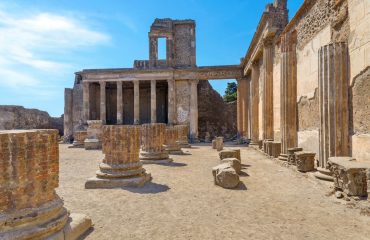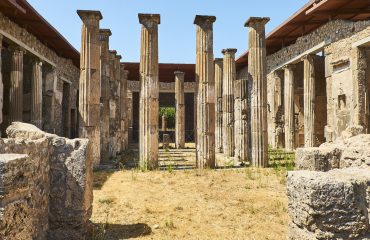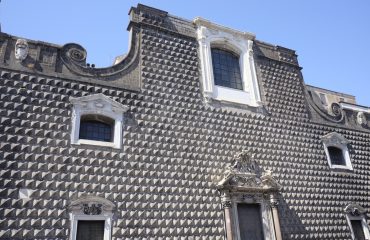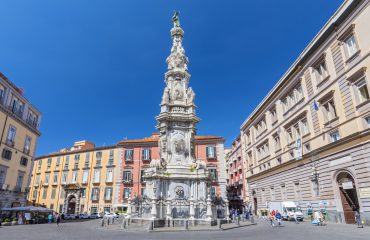REWINDING THE CLOCK
Pompeii & highlights of Naples (shore excursion)
- Explore one of Italy’s most mind-blowing archaeological sites and learn how a natural disaster in 79 AD has allowed the contemporary world to access priceless historical evidence
- Experience the chaotic beauty of Naples’ historic centre, fully qualified to appear on the UNESCO list of World Heritage Sites
- Take a stroll around the 18th century cloister of the Church of Santa Chiara, decorated with brightly coloured majolica tiles
-
Category
-
Hobbies & Interests
-
Duration8 hours
-
Destination
REWINDING THE CLOCK
Pompeii & highlights of Naples (shore excursion)
As you disembark your cruise ship in Naples, meet your private guide and driver and enjoy a full-day tour of one of the world’s most famous archaeological sites and a bustling modern-day metropolis.
Buried in deadly volcanic ash after the sudden eruption of Mount Vesuvius in 79 AD and accidentally discovered in 1748, Pompeii is an absolute must for first-time visitors to Italy. Your guide will take you on a carefully planned trail through this incredible ancient settlement and explain the purpose and function of the foundations and buildings you will see along the way. You will also find out about the lifestyle and customs of those who inhabited them, the techniques used to uncover and interpret findings made here and the evidence that has been pieced together to give us such a stunningly vivid and accurate picture of Roman Campania. Although much excavation work remains to be done and conservation presents the curators with a massive challenge, what you can still see and touch here is simply astounding.
Step back in time as you access the excavations through the city gate of Porta Marina. Once inside, follow your guide through the ruins of the ancient city and conjure up scenes of Pompeii’s inhabitants while they go about their daily chores. Can you imagine how life must have been in this once thriving agricultural and trading centre peacefully perched in the shadow of mighty Mount Vesuvius, unaware of the imminent disaster, 2,000 years ago? How did Pompeii’s 15,000 residents spend their time? What were their occupations, beliefs and traditions? What did they eat? Which leisure activities did they enjoy? The answers to these and many more questions are securely safeguarded within Pompeii’s crumbling walls, jigsaw pieces in a tantalizing, real life puzzle just waiting to be reassembled – with a little help from your guide.
When you stroll along the well-planned streets, taking the very same route once trodden by faithful temple-goers and busy market traders, you’ll notice the road building skills that were needed to set the large paving blocks in place and the high kerbs and stepping stones conveniently arranged to allow people to cross without getting their feet wet and dirty. This is just one small but significant example of the ingenuity of the ancient Romans in the fields of engineering and urban planning, achievements which remained unequalled for centuries and whose remarkable legacy continues to guide us to this day. Our culinary habits, pastimes and vices too may well have their roots here. From fast foods to spas, from red light districts to gambling the ancient Romans of Pompeii were already seasoned experts in the pleasures and transgressions of the city.
Your guide will certainly point out Pompeii’s age-old venues for public meetings: the forum, once the site of the market, administrative offices and court; the thermal baths where citizens came to relax, play sports and socialize; the temples, a source of precious clues to our understanding of the creed and religious rituals of yesteryear’s worshippers. Theatres were popular with the locals who gathered here to watch a varied calendar of shows, such as Greek tragedies, musical performances, poetry readings and the much-loved light-hearted plays that featured frauds, betrayals and brawls. You will also take a peek inside a private residential villa which provides a wonderful example of the layout of a wealthy citizen’s dwelling and the decorative tastes of the age.
Casts of the bodies of the ill-fated population, trapped forever at the very moment of death, leave the visitor with a particularly haunting memory of a cataclysmic event that has meticulously secured for us so much priceless knowledge about the Roman way of life.
Rejoin your driver and return to Naples for some free time for lunch. In the afternoon discover the city’s fascinating past on a guided walking tour of well-loved landmarks.
Your Naples exploration begins with a visit to the Church of Gesù Nuovo. Originally built in the 15th century as a private noble mansion and converted into a Christian temple by the Jesuits in the late 1500s, the church still preserves the striking facade of the original Palazzo Sanseverino with its distinctive diamond-shaped ashlars. Inside an eclectic, flamboyant parade of Baroque virtuosity, brimming with frescoes, stuccoes and coloured marble decorations, attests to Naples’ prime role in fostering the greatest talents of the 17th century, including Francesco Solimena, Luca Giordano and Cosimo Fanzago.
Just a few steps away, guests may admire a preview of paradise as they wander through the cloister of the Church of Santa Chiara, once a place of private contemplation for the nuns of the Order of Saint Clare. Bright hand-painted majolica tiles depicting figs, citrus fruits and vines adorn the sixty-four octagonal columns while the ceramic benches feature everyday scenes of urban and rural life in the 1700s. Additional splashes of green are provided by the garden’s hedges, lemon and orange trees, whose vivid leaves stand out against the cerulean backdrop of the Neapolitan sky.
From here amble along Via Benedetto Croce, cross Piazza San Domenico Maggiore and reach the mysterious Sansevero Chapel. Prince Raimondo di Sangro drew up the iconographic layout of the interior and commissioned skilful 18th century artists with the task of embellishing its walls with allegorical statues. Accounts of the prince’s beliefs, alchemic practices and fascination with the occult will surely intrigue you as you unravel the underlying meaning behind the works displayed here. Giuseppe Sanmartino’s amazingly realistic sculpture of the Veiled Christ is among the chapel’s highlights together with the so-called anatomic machines, two authentic human skeletons bearing precise reproductions of arterial and nervous systems made from beeswax, iron wire and silk… a puzzling, somewhat macabre sight that sparked rumours and dark legends about Prince di Sangro’s evil powers.
Other, more joyful surprises await you in Via San Gregorio Armeno, known for its artisan workshops selling hundreds of exquisitely crafted statuettes and figurines for traditional nativity scenes. Detailed miniatures of the Holy Family, shepherds and donkeys together with representations of pizzerias, fruit markets, gastronomic delights and caricatures of politicians spill out onto the street in a uniquely Neapolitan fusion of the sacred and the profane, of intense creativity and humorous insight.
In the afternoon climb back on board your cruise ship after an unforgettable Campanian excursion.
- A Mercedes vehicle and professional driver at your disposal for a full-day excursion to Pompeii and Naples from the port of Naples (approx. 8 hours)
- A full-day private tour of Pompeii and Naples with an expert licensed guide
- Entrance tickets to the archaeological excavations in Pompeii
- Entrance tickets to the the cloister of Santa Chiara
- Entrance tickets to the Sansevero Chapel
- Tips
- Meals
- The order of the sites visited may change






